Overview
Outdoor area lighting can be defined as streets, roadways, parking lots and pedestrian walkways. These applications have been subjected by conventional lighting technologies such as high-intensity discharge (HID) lamps and fixtures. HID lighting has been utilized for many years in outdoor area lighting applications and have well-documented performance attributes. Today’s advancements in Light Emitting Diode (LED) technology have resulted in a new alternative for outdoor area lighting, which has several advantages over existing conventional lighting.
Seven Key Sustainability Projects |
|
|---|---|
| 1. Metering | 5. Lighting |
| 2. Demand Control | 6. Heat Recovery |
| 3. HVAC Optimization | 7. Project Implementation |
| 4. Compressed Air | |

Unlike conventional HID lighting, LEDs do not have a filament to burn out or break, making them extremely durable. Instead a very small semiconductor chip runs electric current through the diode, which in turn drastically increases the longevity of the light source. Because there are no filaments to heat up, LEDs are “instant on”. This makes them convenient for use in applications that are subject to frequent or potential on-off cycling, as well as circumstances where motion detectors are used. LED product quality can differ amongst manufacturers. Therefore, when choosing LED lighting, due diligence should be applied for an appropriate selection in achieving the best lighting quality and greatest energy efficiency for the associated cost. Furthermore, it is difficult to acquire long term data and testing results, as LED lighting rapidly evolves with technological advancements, meaning existing data is often deemed as obsolete. Interested users should research and compare manufacturers’ technical data and information on various LED products, performances, qualities and lifetimes.
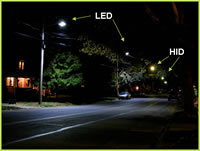
Well-designed LED outdoor luminaires can provide the required surface illuminance while consuming less energy and improving lighting quality and uniformity. LED luminaries also have significantly longer rated life (50,000 hours or more, compared to 15,000 to 35,000 hours of conventional HID lighting) while also drastically decreasing maintenance costs. LED environmental benefits include: no mercury content, lead, or other known hazardous materials that are often associated with conventional outdoor area lighting; while using less power to distribute more light.
Design and Specification Considerations
Several dynamics go into the design and specification requirements for outdoor area lighting. Energy efficiency is a priority in these applications due to the long operating hours and comparatively high wattages that are typically associated with conventional lighting. The essential deciding factors that are linked to the overall quality of the lighting fixtures are: energy efficiency, durability, color quality, longevity, maintenance, light distribution and pollution, as well as initial costs.
Environmental and Energy Efficient Qualities
As previously stated, LEDs contain no mercury, lead or hazardous materials. The reduction in energy consumption also decreases the carbon emissions associated with powering the existing conventional lighting. This environmental benefit also eliminates any costs associated with proper disposal at the end of its useful life. Although LEDs require less energy to operate they often have a higher initial cost than HID lighting. Energy and cost savings that correlate with the use of LED outdoor area lighting has been estimated to be approximately 50-80%, depending on the LED product line, when compared to conventional HID lighting.
Unlike conventional HID lighting, LEDs do not have a filament to burn out or break, making them extremely durable. Instead a very small semiconductor chip runs electric current through the diode,
which in turn drastically increases the longevity of the light source. Because there are no filaments to heat up, LEDs are “instant on”. This makes them convenient for use in applications that are subject to frequent or potential on-off cycling, as well as circumstances where motion detectors are used. LED product quality can differ amongst manufacturers. Therefore, when choosing LED lighting, due diligence should be applied for an appropriate selection in achieving the best lighting quality and greatest energy efficiency for the associated cost. Furthermore, it is difficult to acquire long term data and testing results, as LED lighting rapidly evolves with technological advancements, meaning existing data is often deemed as obsolete. Interested users should research and compare manufacturers’ technical data and information on various LED products, performances, qualities and lifetimes.
A municipality in Ellwood City, Allegheny County, Pennsylvania converted their HID street lights to Appalachian Lighting System’s LED street lights. The municipality immediately recognized considerable cost savings. The existing wattage was reduced from 205W with HID lighting (including ballast) to 66W with LED lighting. Reduction increases an additional 75% between 2 am and dawn because of scheduled power down during off peak hours. In addition light levels increased due to the lack of lumen depreciation that occurs with conventional HID fixture(s). The municipality realized an 80% decrease in wattage and saw their annual savings on utility expenses decrease from \$86,000 a year to \$8,000 a year.
Below is a chart illustrating the comparison between the HID lighting and LED lighting:
| HID | LED | |
|---|---|---|
| Wattage | 295 | 70-94 |
| Energy cost 5000 hrs/yr @ \$0.10/kwh |
$147.50 | $35-$45 |
| # of Lamps | 1 | LED Board |
| # of Ballasts | 12 | N/A |
| Lamp Life | 2-3 Years | 20+ Years |
| Ballast Life | 4-5 Years | N/A |
| Lamp Cost | $18.50 | N/A |
| Ballast Cost | $65.00 | N/A |
| Disposal Cost | Yes | No |
| Mercury Content | Yes | No |
| Instant On/Off | No | Yes |
| CO2 Emission | .43 Lbs/hr | .11-.14 Lbs/hr |
Please Note:
* Chart is based on single street light fixture.
* Information was taken from the retrofit before and after fixtures used in Ellwood City
Color
The light emitted by LEDs provides an accurate rendering of the object’s natural color. LED outdoor area lights have been designed to produce a cool, white, light that range from 85 to 90 (on a scale of 100) on the color rendering index (CRI). Compared to conventional HID lighting, there is a 20% improvement in an observer’s ability to discern color difference in objects. The most efficient white LEDs at this time emit light between 4500K to 6500K correlated color temperatures (CCT). This renders the light from white to bluish-white in appearance. Some LED luminaire manufacturers mix LEDs of various color temperatures to reach a target CCT for the array or luminaire, balancing the highest efficacy sources with warmer LEDs. Color rendering varies according to the make, model and CCT of the LEDs. The color index and temperature produced is also beneficial for security lighting. LEDs produce a direct point of light with the ability to adjust to the target area. There is often no glare or blurred images on security cameras as the light does not aim at the camera. Therefore it is not reflecting off of the lens and distorting the images.
Life and Lumen Maintenance
Estimating LED life can be challenging because of the long projected lifetimes that make full life testing difficult. As LED technology continuously progresses, it often renders any past testing results as obsolete. Many LED manufacturers state lifetime expectancies of up to 100,000 hours (with less than 15 percent lumen depreciation over the 100,000 hours of operation). This is several times longer than the operating life of conventional lighting. Because many LEDs may last more than 10 years, the purchaser saves on the maintenance costs associated with replacing and relamping bulbs and fixtures on a regular cycle that occur with conventional lighting. If the LEDs are driven at lower current and/or maintained at lower temperatures, useful life may be greatly increased. As a result, well-designed LED luminaires are less likely to fail suddenly than to depreciate slowly over time. Decrease in light output occurs in every form of lighting, whether it be LED or HID. The important factors are how much light depreciates, at what rate, and how the light performs at the end of useful life.
Light Distribution and Glare
 Light pollution is defined as light that is generated in excess of what is needed to reach lighting goals. Examples being; skyglow, light trespass and glare. Skyglow is caused by inadequately designed, unshielded and improperly aimed fixtures, creating a “dome” of wasted light making it difficult to see the night sky. Light trespass occurs when light is not aimed properly or shielded effectively and spills onto areas that are not included in the lighting goals for a property. For example: a parking lot light from a shopping center illuminates a neighboring backyard. Glare is visual discomfort caused by excessive brightness, which often occurs in conventional outdoor area lighting because of the non-directional characteristics of the light source.
Light pollution is defined as light that is generated in excess of what is needed to reach lighting goals. Examples being; skyglow, light trespass and glare. Skyglow is caused by inadequately designed, unshielded and improperly aimed fixtures, creating a “dome” of wasted light making it difficult to see the night sky. Light trespass occurs when light is not aimed properly or shielded effectively and spills onto areas that are not included in the lighting goals for a property. For example: a parking lot light from a shopping center illuminates a neighboring backyard. Glare is visual discomfort caused by excessive brightness, which often occurs in conventional outdoor area lighting because of the non-directional characteristics of the light source.
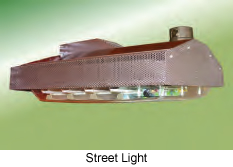
As America becomes more conscientious of the side effects and negative consequences of outdoor area lighting, we attempt to replace the orange glow of the cities and streets to the night skies that once existed. Academic studies performed over the last several years have contradicted the myth that “more light is better”. When selecting lighting for outdoor area lighting, consider the use of LED lighting but make sure to choose the correct LED lighting fixtures that properly direct light towards surfaces that are intended to be lit. This provides more effective use of the light and limits the light pollution often associated with conventional lighting.
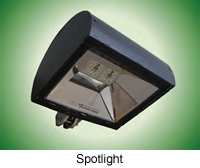
LED luminaries use different optics than HID lighting. Each LED diode is, in affect, a direct point of light. Effective luminaire engineering utilizes the directional characteristics of LED light emission, in turn decreasing optical losses while increasing luminaire efficacy and providing more uniform light distribution across a targeted area. Improved surface lighting uniformity and higher levels of vertical illuminance are possible with LEDs and close-coupled optics.
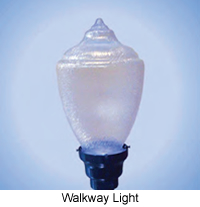
Checklist for Choosing a Superior Outdoor Area Lighting
LED lighting technology is emerging to be a leading lighting source for outdoor area lighting applications. New products are being introduced and technology is advancing rapidly. As with all LED products, thorough informational planning and research is suggested to assess quality, performance, and overall value. Follow the checklist below as a guideline to investigate the best high quality LED lighting.
- Find out the warranty; 3 to 5 years is reasonable for outdoor luminaires. Be sure to read the fine print.
- Retrieve operating temperature data and verify how this data relates to luminaire efficacy and lumen depreciation.
- Appraise color temperature for suitability in the intended application.
- Assess glare, preferably with the luminaire at intended mounting height and under typical nighttime viewing conditions, compared to the existing conventional lighting.
- Evaluate the LED to HID lighting economic payback, based on wattage, energy use, maintenance savings, operating hours and operating costs for the application.
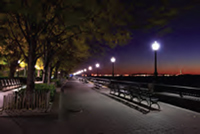
Photo Credits: Appalachian Lighting Systems
For more information, please contact Ted Stouch, Stouch Lighting, tel: 866-964-8559, email: tstouch@stouchlighting.com, www.stouchlighting.com




